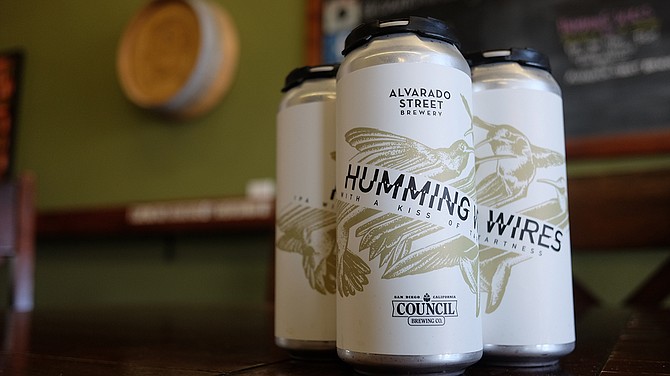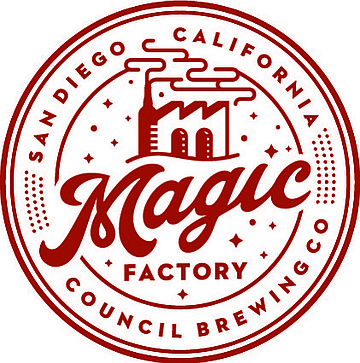 Facebook
Facebook
 X
X
 Instagram
Instagram
 TikTok
TikTok
 Youtube
Youtube

Council Brewing Company is set to launch a spin-off sour brand. The Magic Factory was initially the name given to Council's second production suite, which sits across the industrial park from its main Kearny Mesa brewhouse and tasting room. It's separated by a parking lot and, as Council cofounder Curtis Chism points out, exactly five speed-bumps — a number familiar to Council brew staff after shuttling totes of beer between the spaces for nearly two years.
Since May 2015, Council has been finishing its flagship Beatitude tart saison series there, with a parade of fruits and a proprietary blend of bacteria and yeast. However, the space has now been outfitted with three foeders, where 15- and 30-barrel batches of sour ales await release as Magic Factory beers in the spring. First up for the new label will be the March bottle release of Lickable Staves, a cabernet-barrel-aged sour red ale with Balaton cherries.
In addition to the foeders and offshoot label, Council has been pushing a creative expansion with a couple of recent collaborations. Humming Wires was brewed in Monterey, in collaboration with Alvarado Street Brewery, which happens to be headed by former San Diegan and Amplified Ale Works cofounder J.C. Hill.
Curtis Chism describes the beer as an "IPA with a kiss of tartness." While making it, "one third of the batch was kettle-soured to lower the pH just a touch to really enhance the fruity profile of the beer." As people associate sourness with fruit, the blended kettle-sour accentuates that aspect of the juicy IPA.
A second collaboration proved more spontaneous. Eighteen months ago, Council head brewer Liz Chism told the Reader, "If you're not using your brewhouse, you're not making money." So, in mid-January, when shipping delays postponed a planned bottling run, she and husband Curtis found another way to make use of the time.
They invited Toolbox Brewing Company head brewer Ehren Schmidt over for a lambic-style, spontaneous beer experiment. In a spontaneous beer, no yeasts are added to the brew; instead, an open fermentation vessel is used so that whatever yeast floating in the air ferments the beer.

After exposing the first batch to the air of the Magic Factory, the collaborating breweries brewed the same wort at Toolbox's Vista brewhouse, where Schmidt keeps a small lab to cultivate his own strains of bacteria and yeast. The idea is to wait a year, then taste how the differences reveal themselves in the final beers.
Traditionally, Belgian lambics incorporate aged hops that are no longer bittering but still prevent the beer from becoming infected by unwanted microorganisms. In this case, three-year-old Crystal hops, described by the brewers as having a blue-cheese aroma, were added to a brew of under-developed pilsner malts, plus both flaked and unmalted wheat.
"Depending on how it turns out, we'll likely do a blend of the two, in addition to unblended releases," says Curtis Chism. Schmidt suggests the two breweries could reconvene next year — and the year after — to reproduce the beer and eventually blend the three versions into a gueuze.


Council Brewing Company is set to launch a spin-off sour brand. The Magic Factory was initially the name given to Council's second production suite, which sits across the industrial park from its main Kearny Mesa brewhouse and tasting room. It's separated by a parking lot and, as Council cofounder Curtis Chism points out, exactly five speed-bumps — a number familiar to Council brew staff after shuttling totes of beer between the spaces for nearly two years.
Since May 2015, Council has been finishing its flagship Beatitude tart saison series there, with a parade of fruits and a proprietary blend of bacteria and yeast. However, the space has now been outfitted with three foeders, where 15- and 30-barrel batches of sour ales await release as Magic Factory beers in the spring. First up for the new label will be the March bottle release of Lickable Staves, a cabernet-barrel-aged sour red ale with Balaton cherries.
In addition to the foeders and offshoot label, Council has been pushing a creative expansion with a couple of recent collaborations. Humming Wires was brewed in Monterey, in collaboration with Alvarado Street Brewery, which happens to be headed by former San Diegan and Amplified Ale Works cofounder J.C. Hill.
Curtis Chism describes the beer as an "IPA with a kiss of tartness." While making it, "one third of the batch was kettle-soured to lower the pH just a touch to really enhance the fruity profile of the beer." As people associate sourness with fruit, the blended kettle-sour accentuates that aspect of the juicy IPA.
A second collaboration proved more spontaneous. Eighteen months ago, Council head brewer Liz Chism told the Reader, "If you're not using your brewhouse, you're not making money." So, in mid-January, when shipping delays postponed a planned bottling run, she and husband Curtis found another way to make use of the time.
They invited Toolbox Brewing Company head brewer Ehren Schmidt over for a lambic-style, spontaneous beer experiment. In a spontaneous beer, no yeasts are added to the brew; instead, an open fermentation vessel is used so that whatever yeast floating in the air ferments the beer.

After exposing the first batch to the air of the Magic Factory, the collaborating breweries brewed the same wort at Toolbox's Vista brewhouse, where Schmidt keeps a small lab to cultivate his own strains of bacteria and yeast. The idea is to wait a year, then taste how the differences reveal themselves in the final beers.
Traditionally, Belgian lambics incorporate aged hops that are no longer bittering but still prevent the beer from becoming infected by unwanted microorganisms. In this case, three-year-old Crystal hops, described by the brewers as having a blue-cheese aroma, were added to a brew of under-developed pilsner malts, plus both flaked and unmalted wheat.
"Depending on how it turns out, we'll likely do a blend of the two, in addition to unblended releases," says Curtis Chism. Schmidt suggests the two breweries could reconvene next year — and the year after — to reproduce the beer and eventually blend the three versions into a gueuze.
Comments